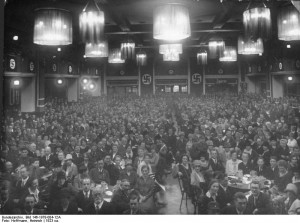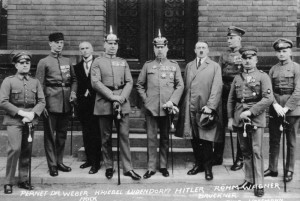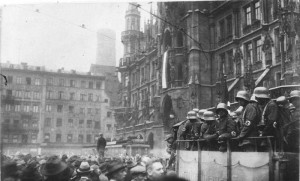Adolf Hitler, along with several members of the National Socialist party, attempted to take control of the German government on November 8, 1923. This failed coup d’état is commonly known as the Beer Hall Putsch, but has also been called the German Bierkeller Putsch, Munich Putsch, Hitlerputsch or Münchener Putsch. This historical event took place in Munich at one of the largest beer halls in the city called the Bürgerbräukeller.
After WWI, Gustav Stresemann had become the Chancellor of Germany, and many Germans were unhappy with the Weimar Republic because of the reparation payments they had to give France in accordance with the Treaty of Versailles. During this period, the Weimar republic was also experiencing hyperinflation which made it difficult for working people to afford the necessities of life.
At the same time, Bavaria was being governed by a triumvirate (three leaders) which consisted of Gustav von Kahr (Generalkommissar), Hans Ritter von Seisser (State Police Chief) and Otto von Lossow (Army General Commander of Bavaria), all of whom had been clashing with leaders in Berlin. Adolf Hitler, who had been given significant political standing by that time, saw it as an opportunity to overtake the government.
The Beer Hall Putsch Plan
On November 8, 1923, Kahr planned to meet with over three thousand Bavarian government officials at the Buergerbräukeller. Considering that all of the triumvirate would most likely be there, Hitler and his followers thought they could convince them to join the party.
Hitler, Ulrich Graf, Alfred Rosenberg, and Anton Drexler, as well as several other men showed up at the beer hall at about 8 p.m. The meeting had begun and Kahr was already speaking to the crowd. At some point between 8:30 p.m. and 8:45 p.m., Hitler went into the beer hall, placed a machine gun at the entrance and had his troops surround everyone inside the hall. He went up to the platform and told the crowd that this was the start of the national revolution.
Hitler then told Kahr, Seisser and Lossow, at gunpoint, to accompany him to an adjoining room. In the midst of this, Scheubner-Richter had gone to get General Erich Ludendorff—a famous military leader who led National Socialist party with Hitler—who had no idea an attempted coup was taking place.
After returning to the room, Hitler took to the podium and started speaking about how Kahr, Seisser, and Lossow, had decided to join the National Socialists, a claim that was received very positively by the crowd. Shortly after, Ludendorff arrived and went in the side room to speak with the triumvirate.
The triumvirate agreed to join and each of them gave a short speech to the crowd. Since the situation was under control, Hitler left to take care of a conflict between his men, leaving Ludendorff in charge.
The Putsch Fails
When Hitler returned, he learned that the triumvirate had been allowed to leave. Soon after, all three of the triumvirate quickly denounced their forced affiliation with Hitler’s party and claimed that they would work against the putsch. Without having the cooperation of the triumvirate, Hitler knew he did not have a sufficient amount of support to fight against the entire army of Bavaria. The putsch had failed. However, the event did give the National Socialists their first piece of national attention which they viewed as a victory of propaganda.
As the Putsch was falling to pieces, Ludendorff, along with Hitler, decided to march the troops to the center of Munich. Since Ludendorff was a celebrated legendary general, he did not think the police would fire upon him or the troopers.
On November 9, 1923, at about 11:00 a.m., around 3,000 troops followed Ludendorff and Hitler as they marched into the center of Munich. The group was met by the police, but they let them pass because Hermann Goering threatened that they were prepared to use their weapons. Ludendorff then yelled out, “Wir marschieren!” (we march) and they continued down the street.
Next, the group of men reached the narrow Residenzstrasse. At the end of this street there was a very large number of police. Hitler was positioned in front and had his right arm linked with Max Erwin von Scheubner-Richter’s arm. The police were informed that Ludendorff was with Hitler and the troops. It is unclear who fired the first shot, but Scheubner-Richter had been one of the first men shot and killed in the ensuing violence. As he fell, he brought Hitler down with him, causing him to suffer a dislocated shoulder.
Ludendorff kept marching forward while many others sought cover or fell to the ground. He walked ahead and eventually marched straight through the police line. He was arrested, and sometime later, it was said that he was quite angry that none of the other troops had followed after him. Goering had suffered a wound to his groin and left for Austria before being arrested. Hitler was arrested two days later. Approximately three or four policemen and about sixteen Nazis died during the Beer Hall Putsch.
After the Failure of the Beer Hall Putsch
Hitler and the many others went to trial and received various sentences. Hitler thought his trial would be a great opportunity to share his political ideas and spoke quite often to the press. However, after the failed putsch, Hitler changed his opinions about violent revolution. He decided that, to win the hearts of the German people, he had to operate strategically within the law.
Hitler spent nine months at the Festungshaft jail, during which he wrote the first volume of Mein Kampf. According to the text, the following troops were killed on November 9, 1923: Wilhelm Wolf, Lorenze Ritter Stransky, Scheubner-Richter, Johann Rickmers, Theodor von der Pfordten,Claus von Pape, Kurt Neubauer, Karl Laforce, Karl Kuhn, Oskar Koerner, Anton Hechenberger, Martin Faust, Wilhelm Ehrlich, Andreas Bauriedl, Theodor Casella, and Felix Alfarth.


